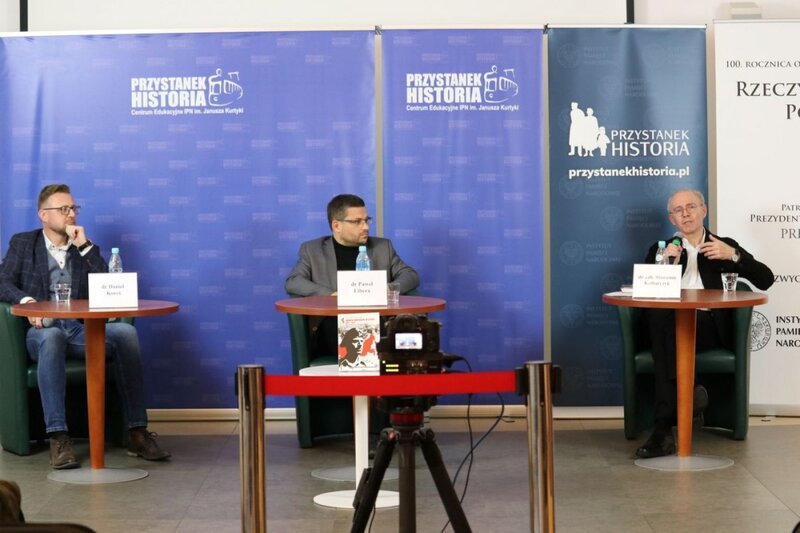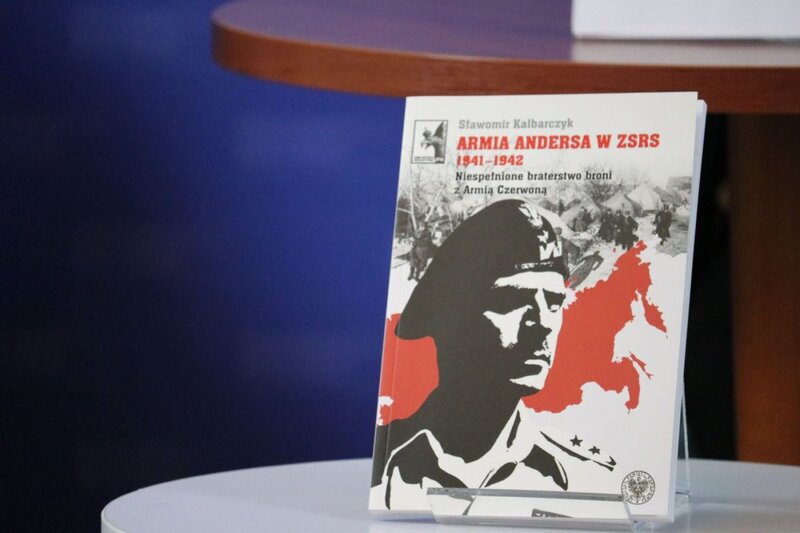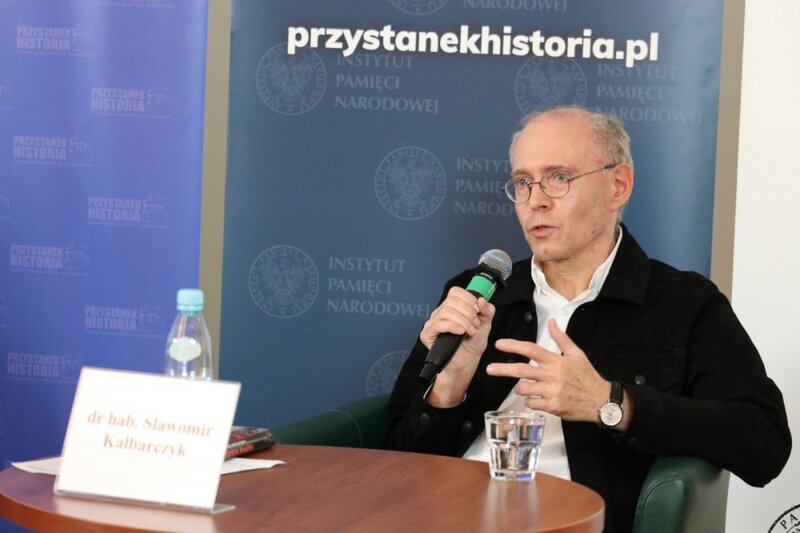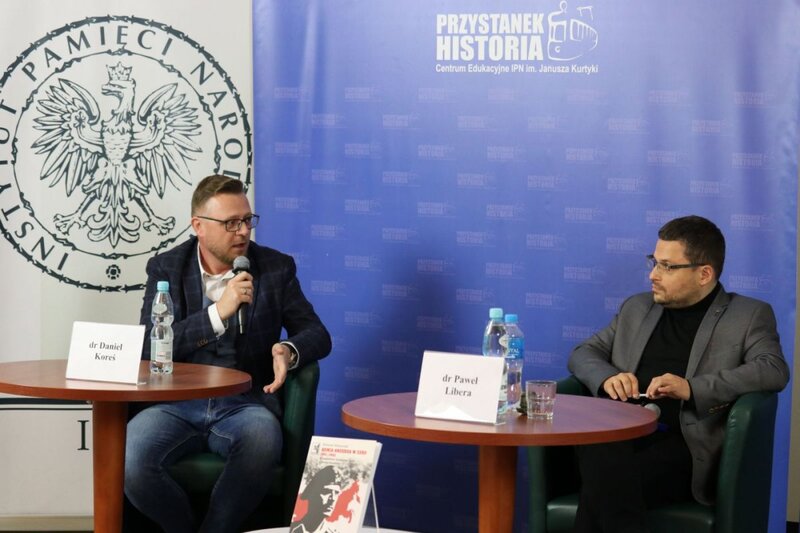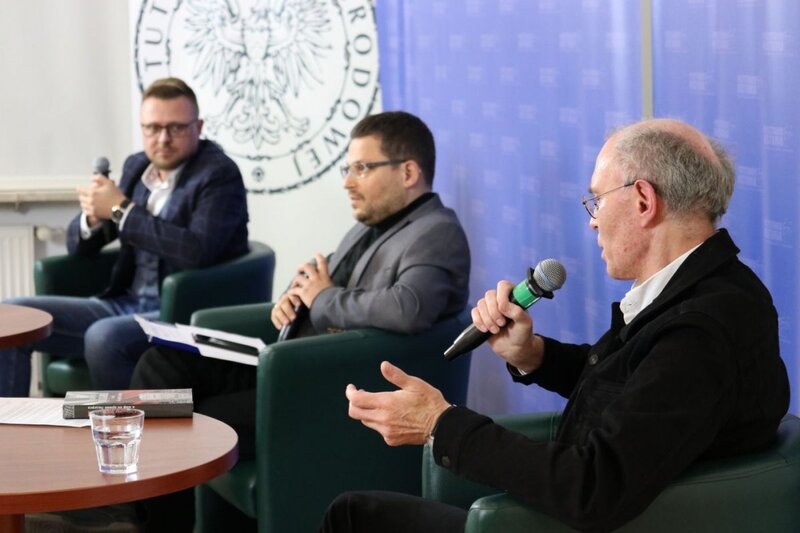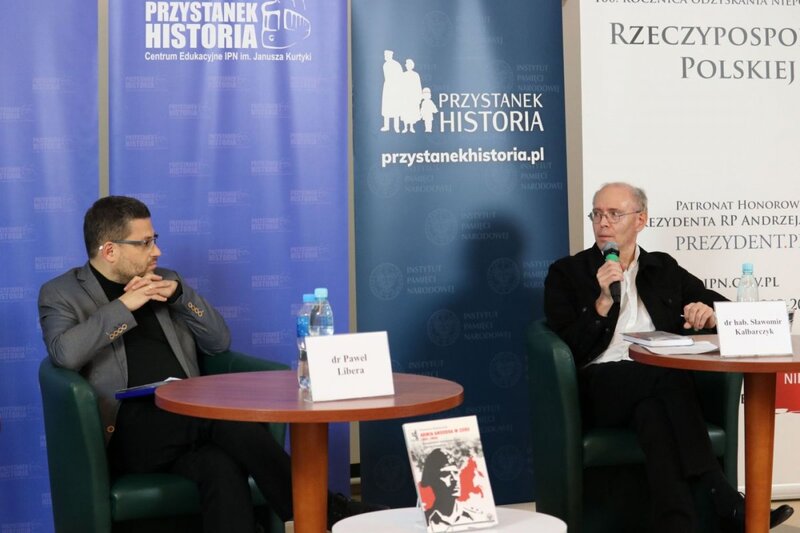Meticulously researched and written in an engaging style, the publication takes the reader through fascinating, behind-the-scenes negotiations in changing political situation, and presents key players – such as Anders, Stalin, Sikorski, Churchill, Harriman or Cripps – who orchestrated or influenced the fate of the Polish troops formed in the USSR.
In yesterday’s discussion, the author was joined by Daniel Koreś, PhD, and Paweł Libera, PhD. Click here for video streaming of the event (in Polish): https://ipn.gov.pl/pl/aktualnosci/110765,Dyskusja-wokol-ksiazki-Slawomira-Kalbarczyka-Armia-Andersa-w-ZSRS-19411942-Niesp.html
General Władysław Anders – a faithful knight of the Republic of Poland
General Władysław Anders died in London fifty years ago, on 12 May 1970, on the 26th anniversary of the beginning of the Battle of Monte Cassino. He was an outstanding military commander, representing the values of the elite of the Second Polish Republic, remaining faithful to the motto of the Polish Army: God, Honor and the Homeland. General Anders’ life perfectly illustrates both the glory and tragedy of Poland and Poles in the 20th century. His death closed an important chapter in the history of post-war independence emigration, which he symbolized.
General Anders was born on 11 August 1892 in Błonie sixty miles west of Warsaw, which was then in the Russian sector of partitioned Poland, to a family of landed gentry. His father Albert was an agronomist and manager of landed estates, his mother Elżbieta looked after the house and their four children. His ancestors fought for the independence of Poland in 1863. Władysław Anders had three brothers, Karol, Jerzy, and Tadeusz, who were also professional soldiers of the Polish Army. All four became Knights of the Order of Virtuti Militari.
“I could proudly wear the Polish Eagle”
Anders graduated from middle school and high school in Warsaw. He began his military career by volunteering for compulsory military service in Tsarist Russia. As a result, he served for a year, not three. In the years 1911-1914 he studied mechanics at Riga Technical University, he was an active member of the Arkonia student fraternity and the semi-underground Polish organization Sokół.
During World War I, he served in the 3rd Novorossiysk Regiment in Kaunas, and then in the 7th Rifle Division of the Tsarist Army. After the February Revolution and the overthrow of the Tsarist regime, he joined the forming Polish Army in Bobruisk. Anders joined the 1st Polish Corps commanded by General Józef Dowbor-Muśnicki in September 1917, years later recalling: "the moment when I joined the 1st Krechowiecki Ulhan Regiment and could wear the Polish Eagle was particularly joyful". He became a squadron commander. Then he was the chief of staff in the 1st Rifle Division of the 1st Polish Corps in the East. After the Corps was disarmed by the Germans in May 1918, he returned to Poland and joined the Polish Army.
At the beginning of 1919, Anders took part in the Greater Poland Uprising, and then, commanding the 1st Greater Poland Uhlans, he fought in the Polish-Bolshevik war, making himself known as an excellent commander. He was badly injured in the leg during the fights. On 22 April 1921, Marshal Józef Piłsudski decorated Władysław Anders with the Order of Virtuti Militari for valour demonstrated during the war with the Bolsheviks.
In the years 1921-1924, Anders studied at École Supérieure de Guerre in Paris. Upon graduation he returned to Poland, where he served on the General Staff of the Polish Army. A year later Anders was awarded the Officer's Cross of the Order of Polonia Restituta. He loved horses and riding. In 1925, he was the head of the Polish Equestrian team which won the Nations Cup in Nice.
During the May Coup d’état, he was the Chief of Staff of the Commander of Government troops, General Tadeusz Rozwadowski. As he admitted: "I remember vividly the tragedy of Piłsudski's attack in 1926, when I had to, in accordance with the military oath defending the rule of law and the President, fight against my own brothers in Warsaw."
"Under the banners of the White Eagle"
After 1 September 1939, General Anders’ command skills, courage and character were put to the test. He fought in the "Modlin" Army, protecting the border with East Prussia, and then in the "Warsaw" Army in the region of Płock and Warsaw, taking part in fierce clashes against the Germans near Mińsk Mazowiecki and Tomaszów Lubelski. After the Soviet aggression, Anders and his soldiers found themselves between the armies of both invaders, and were forced to retreat towards the Hungarian border. Wounded twice, the General was taken prisoner by the Soviets on 29 September near Lviv, to be detained in the worst of their prisons – Brygidki in Lviv, and then Butyrki and Lubyanka in Moscow. In nearly two years of incarceration, he was brutally interrogated, beaten, starved, and repeatedly pressed to join the Red Army.
Anders was released on 4 August 1941, and, following the Sikorski-Mayski agreement, Prime Minister and Commander-in-Chief General Władysław Sikorski gave him the task of creating and commanding the Polish Armed Forces in the USSR. Despite health problems, he immediately began gathering the troops: on 22 August 1941, he issued Order No. 1, calling on "all able-bodied Polish citizens to fulfill their duty to their country and to join the banner of the White Eagle."
In his radio speech of 17 October 1941, General Anders said, “One might ask what our soldiers, scattered all over the world, are fighting for. There is only one, simple and clear answer: we fight for justice and for our nation, we fight for free and independent Poland, which every nerve in our body is craving so badly. We know that great hardships await us, that the way will be tough and bloody, and that perhaps not all of us will succeed. But we’ll get there eventually – so help us God!"
Hungry, scruffy and sick – yet filled with faith and hope – the soldiers and civilians released from Soviet prisons and labour camps flocked to the Polish Army. In mid-October 1941, it numbered over 40,000 people, but missing were the officers from the camps in Kozelsk, Starobelsk and Ostashkov. Gen. Anders’ efforts to obtain any explanation of their fate from the Soviet authorities brought no results, and the mission of investigating what happened to them, which he tasked cavalry Captain and former Starobelsk POW Józef Czapski with, also failed.
The Soviets stalled the formation of the army and cut down the supply of food, medicines and equipment. The conditions deteriorated, jeopardizing the health and lives of the soldiers and their families. On 7 June 1942, General Anders informed the Commander-in-Chief, “Our situation is becoming disastrous. . . There is no hope of improvement, on the contrary – things keep getting worse”.
The only option was to evacuate to the Middle East. Gen. Anders made sure that the Polish civilians could leave the "inhuman land" with the army. In two evacuations between March and November 1942, over 115,000 people – 78,500 soldiers and 37,000 non-combatants, including ca. 18,000 children – departed for Iraq.
The new route of General Anders' army led through Iran, Iraq and Syria to Palestine. On 21 July 1943, General Anders took command of the Polish 2nd Corps, which he would later lead to the Italian front.
The Italian campaign climaxed in the Battle of Monte Cassino, the toughest and bloodiest clash between the Western Allies and Germany on the Peninsula, but one that opened the way to Rome to the former. On 11 May 1944, the day before the attack, General Anders wrote in his order:
The task that has befallen us will bring worldwide glory to the Polish soldier. In these moments of trial we will be in the minds and hearts of the entire Polish nation. The spirits of our fallen brothers in arms will support us. Let the lion awake in your heart! Soldiers – remembering Germany’s bandit attack against Poland, the German-Soviet partition of Poland, the thousands of ruined towns and cities, the murder and torture of thousands of our brothers and sisters, the millions of Poles deported to Germany as slaves, the plight and sorrow of our country, our suffering and exile – we march on trusting the justice of Divine Providence, with the holy motto of “God, Honor, Homeland” in our hearts.
“You are not fighting for Monte Cassino, but for Poland's freedom," he added.
The battle for Ancona, fought between 13 and 18 July 1944, the only independent operation of the Polish 2nd Corps, ended with victory. Gen. Anders showed his commanding skills again, and Gen. Harold Alexander remarked on the Polish soldiers, "This is one more proof of the greatness of the Polish Army."
After the Yalta conference, General Anders cabled President of the Republic of Poland Władysław Raczkiewicz, "In view of the tragic message of the last conference, I report that the 2nd Corps does not recognize the unilateral decision of leaving Poland and the Polish nation to the Bolsheviks."
Briefly, between 26 February and 28 May 1945, Anders became the Acting Commander-in-Chief of the Polish Armed Forces, a responsibility he handed over to General Tadeusz Bór-Komorowski.
General Anders deserves praise for creating the 2nd Corps’ "wandering" little Poland, which covered the way from Iraq to Italy, while developing vibrant cultural life – with books, press, libraries, exhibitions, film and theatre. He took care of educating the children and youth, and secured university scholarships for them. The continuity of Polish culture, ethnic identity, and tradition of the multinational Republic of Poland were preserved.
Another thing Anders preserved and honoured was the memory of Polish officers murdered by the NKVD in Katyn: he created the Archive and Records Office of the 2nd Corps, and gave it a task of collecting testimonies, documents and reports on this heinous crime. The General also penned the introduction to "The Katyn Massacre in the Light of Documents" edited by Józef Mackiewicz, and ensured the book’s publication.
"We will not return before Poland is free"
After the war, he stayed in exile "to fight for Poland and to return to Poland." He opposed the communist rule in the country, and its sovietization. On 26 September 1946, a resolution of the Council of Ministers of the Warsaw government deprived him of his Polish citizenship, for "activities threatening the most vital interests of the Polish State, its security and the entirety of its borders".
Gen. Anders took an active part in the cultural, social and political life of Polish expats. He became a political leader, not a politician, and thanks to his contacts with Allied commanders and Western politicians, one of the key figures of the emigrant circles.
In the years 1946-1954, he was the Commander-in-Chief and Inspector General of the Armed Forces. From 1950, he chaired the Main Committee of the National Treasury. After a political split in 1954, he became a member of the Council of Three, on which he sat until his death. In 1953, he took over the chairmanship of the Polish Educational Society, and in the years 1953-1964 he chaired the Polish Cultural Foundation.
He greatly contributed to the continuation of the publishing activity of the 2nd Corps in exile, and the 1946 establishment of two publishing houses – Gryf in London and Libella in Paris. In the years 1959-1970, he chaired the Polish Cultural Foundation in London, which published, among others, "Dziennik Polski", ["The Polish Daily”], books and brochures.
At his table in "Ognisko Polskie", ["The Polish Hearth"], a club and restaurant that brought together the Polish community in London, he enjoyed chatting with poets and writers, such as Kazimierz Wierzyński or Marian Hemar.
He remained the undisputed authority for his subordinates, a symbol of patriotism and an uncompromising attitude towards communism. He died on 12 May 1970, and nine days later was laid to rest with his men of the 2nd Corps in the Monte Cassino cemetery, as was his last will, mourned by relatives and faithful soldiers of the Polish Armed Forces.
